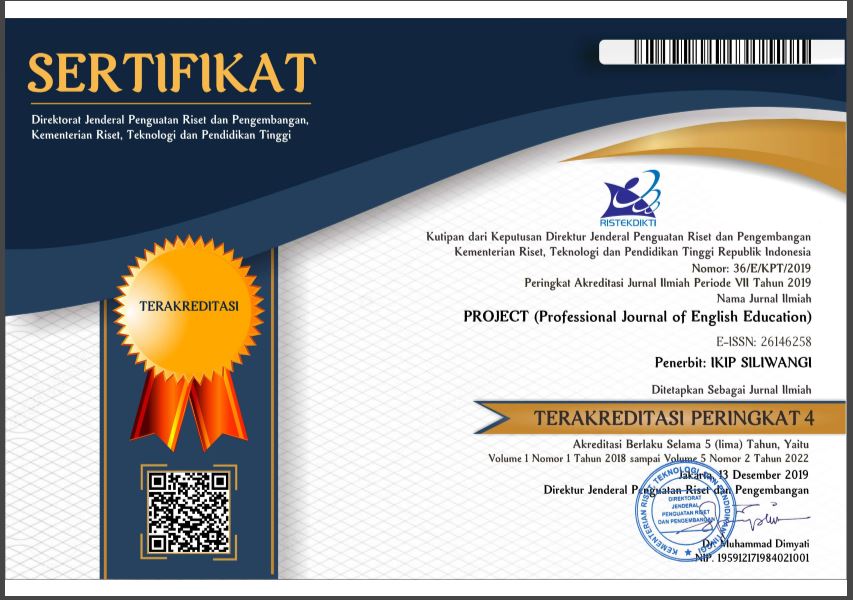EFL Students’ Perception in Using Duolingo for Developing Speaking Ability
Abstrak
English-speaking ability is an essential skill for EFL students to communicate effectively; however, many students face challenges such as limited vocabulary, lack of motivation, and low self-confidence. Therefore, the study "EFL Students’ Perception in Using Duolingo for Developing Speaking Ability" aims to analyze students' perceptions of using Duolingo to improve their speaking skills, focusing on how the application's features assist in speaking development and its effectiveness in English language learning at senior high schools in the Greater Jakarta area. This research using quantitative method, with data collected through a Likert-scale questionnaire administered to 25% of 187 randomly selected students. The results indicate that students have a positive perception of Duolingo due to features such as a reward system, learning reminders, and game-based multimedia content, which enhance motivation, confidence, learning flexibility, and active participation in speaking. However, challenges such as limited vocabulary and fear of making mistakes still persist, suggesting that while Duolingo is an effective learning tool, its use should be supplemented with conventional teaching methods for optimal improvement in English-speaking skills.
Referensi
Arikunto, S. (2010). Prosedur penelitian suatu pendekatan praktek.
Dewi, S. K., & Sudaryanto, A. (2020). Validitas dan reliabilitas kuesioner pengetahuan, sikap dan perilaku pencegahan demam berdarah. In Prosiding Seminar Nasional Keperawatan Universitas Muhammadiyah Surakarta (Vol. 75).
Fauzan, F., & Kasim, U. (2020). Exploring the implementation of Duolingo media for assignment in learning English. English Education Journal, 11(2), 288-301.Fitria, N., Usman, M., & Sahara, N. (2023). Duolingo Application for Advancing English Speaking Skills. Journal of Innovation in Educational and Cultural Research, 4(4), 587–595. https://doi.org/10.46843/jiecr.v4i4.630
Jiang, X., Rollinson, J., Plonsky, L., & Pajak, B. (2020). Duolingo efficacy study: Beginning-level courses equivalent to four university semesters. Duolingo efficacy study: Beginning-level courses equivalent to four university semesters.
Kamsik, A. E., Daud, A., & Masyhur, M. (2023). Students’ perception on the use of the Duolingo application as a medium for developing university-level English language skills. Journal of English Language Teaching and Learning (Jetle), 5(1), 1-19.
Marzuqi, I. (2019). Pendidikan dan Latihan Profesi Guru (PLPG) Mapel Dalam Pembelajaran Bahasa Dan Sastra Indonesia.
Pramesti, A. S., & Susanti, A. (2020). Students’ perception of the use of mobile application Duolingo for learning English. International Journal of Scientific and Technology Research, 9(1), 1800-1804.
Riadil, I. G. (2020). EFL students in speaking skill: identifying english education students’ perceptions of the psychological problems in speaking. JETAL: Journal of English Teaching & Applied Linguistic, 2(1), 8-20.
Serhan, D. (2020). Transitioning from Face-to-Face to Remote Learning: Students' Attitudes and Perceptions of Using Zoom during COVID-19 Pandemic. international Journal of technology in education and Science, 4(4), 335-342.
Sinh, B. , D., Thy, N. , H., Tien, N. , Van, Thuy, N. , Van, & Tran, P. , L. K. (2021). Students’ Perception Of Online Learning During Covid-19 Pandemic In Vietnam - A Case Study On The Students Of Banking University Of Ho Chi Minh City. Natural Volatiles & Essential Oils, 8(2), 190–201.
Sugiyono, P. (2011). Metodologi penelitian kuantitatif kualitatif dan R&D. Alpabeta, Bandung, 62, 70.
Syafrizal, S., Cahyaningrum, N. S., & Syamsun, T. R. (2022). Duo Lingo Application for Teaching Speaking Skills Class: Students' Perception of Speech Ability. IDEAS: Journal on English Language Teaching and Learning, Linguistics and Literature, 10(1), 1041-1049.
Su, A. A. T., Cao, T. X. T., & Nguyen, T. L. A. (2021). Improving English Speaking Ability Through E-Learning. AsiaCALL Online Journal, 12(2), 58-71.
.





